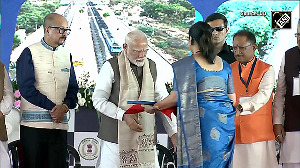Centre meets target of 18,000 villages but household metering remains a challenge

The Narendra Modi-led government on Sunday celebrated meeting the target of connecting all villages of the country to the national electricity grid.
The government started electrifying 18,000 villages, which did not have access to power, in 2015 and has already connected them to the central grid ahead of the 2019 deadline.
Prime Minister Narendra Modi tweeted from his personal handle “28th April 2018 will be remembered as a historic day in the development journey of India. Yesterday, we fulfilled a commitment due to which the lives of several Indians will be transformed forever! I am delighted that every single village of India now has access to electricity.”
What, however, is left to achieve is 100 per cent electrification in all rural households and metering them for reliable and steady power supply.
Of the 170 million rural households in the country, the government website claims to have connected 82 per cent of them. Metered households are 50 per cent of the total.
As of February this year, of the 780,000 villages in which power connection was to be provided to all households, 493,000 have been covered.
However, the amount and quality of power supply cannot be ascertained from this set of data.
Besides, no clause in any rural electrification programme promises power supply throughout the day.
This, in a way, is passing the buck to the states to provide electricity to every rural household.
However, the financial and operational conditions of state-owned power distribution companies (discoms) and the slow pace of reforms in most of them might be a hindrance.
The aggregate technical & operational losses (AT&C) of the country, which depict the operational losses of the discoms, stand at 21.35 per cent. For large states such as Uttar Pradesh (UP), they are 30.94 per cent, for Bihar 36.75 per cent, for Rajasthan 24 per cent, and for Punjab 29 per cent.
The data sourced from government websites indicates that the states where losses are high are relatively slow in electrifying rural households.
For instance, in UP, 50 per cent of the households are metered. In Rajasthan and Uttarakhand, it is zero.
Feeder segregation, which involves separating the power feeder for urban and rural domestic consumers, and rural agriculture, has been good in states such as Andhra Pradesh, Karnataka, Haryana, and Maharashtra.
“Getting all villages electrified is a transformative event in the history of this country. It also helped in appropriately estimating, planning and budgeting for complete household electrification over the next two years.
"Investments in information technology infrastructure will bear fruit to realise the dream of 24 hours’ reliable power by 2022.
"Utilities need to involve the private sector in improving their business models and improving revenue realisation,” said Sambitosh Mohapatra, partner (power & utilities), PwC India.
The Union government last year announced a scheme - Sahaj Bijli Har Ghar Yojana (Saubhagya) - to speed up electrification. The outlay for the Saubhagya project is Rs 16,320 crore, while gross budgetary support is Rs 12,320 crore.
The central government will provide funds to states to subsidise power connections for rural and urban households.
The other two schemes for reforming power infrastructure - Deen Dayal Upadhyaya Gram Jyoti Yojana (DDUGJY) in rural areas and Integrated Power Development Scheme (IPDS) in urban areas - received Rs 5,821 crore and Rs 4,814 crore, respectively, as budgetary allocation last year.
This year, the DDUGJY got Rs 3,800 crore and Saubhagya Rs 2,750 crore as additional budgetary support in the Union Budget 2018.
The fund disbursement under the DDUGJY stands at Rs 380 crore to date and Rs 26,900 crore under the IPDS.
The fund sanction depends on the projects taken up by states.
Of the 3,867 projects in the DDUGJY, 2,110 have been commissioned.
Photograph: Reuters












 © 2025
© 2025